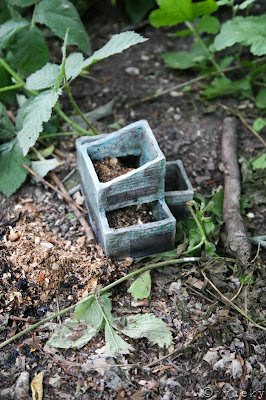This title above is a bit confusing . One didn't have anything to do with the other. I just came back from a very interesting activity, Raku firing. And I baked some banana cupcakes and brought it along for this occassion. Nobody was here in the photo, everyone was off to work & firing.
It was said, ceramics were being most likely handshaped than thrown.
Ceramics were to be placed in kilns to reach a low temperature firing of about 900 degrees Celcius.
After they were fired in low temperature the pottery will be removed from kiln while still glowing hot. It will be then be placed in a container with combustible materials to be ignited. This causes reactions creating pattern and colour.

The symbol of Raku accoding to Wikipedia http://en.wikipedia.org/wiki/Raku_ware
Raku means "enjoyment", "comfort" or "ease" and is derived from Jurakudai, the name of a palace, in Kyoto, that was built by Toyotomi Hideyoshi (1537–1598), who was the leading warrior statesman of the time.
In the 16th century, Sen Rikyū, the Japanese tea master, was involved with the construction of the Jurakudai and had a tile-maker, named Chōjirō, produce hand-moulded tea bowls for use in the wabi-styled tea ceremony that was Rikyū's ideal. The resulting tea bowls made by Chōjirō were initially referred to as "ima-yaki" ("contemporary ware") and were also distinguished as Juraku-yaki, from the red clay (Juraku) that they employed. Hideyoshi presented Jokei, Chōjirō's son, with a seal that bore the Chinese character for raku[1]. Raku then became the name of the family that produced the wares. Both the name and the ceramic style have been passed down through the family (sometimes by adoption) to the present 15th generation (Kichizaemon). The name and the style of ware has become influential in both Japanese culture and literature.
I checked with some friends whom are expert in chinese characters that the character raku actually means pleasure and joy. And how poetically the upper part of the character represents white and the bottom part represents wood.
How appropriately I found out there is actually wood element in this process, the sawdust.
and be cooled in the water.
I wish my camera could have captured the smoke over these pieces. They were smoking hot.
Smoked duck, no joke.
Frog was there the whole time laughing at the smoking pieces rested there to be cooled off.
I am not going to post anybody's photos here. Not wanting to be sued by my teacher and fellow classmates for publishing their photos without asking.
These cloth seems to work to dampen the smoke condition.
A session of cleaning and washing some ashes off the pieces.
These are mine, still lots of room for improvement.
Like all good things it all had to come to an end. Soon I found myself and others collecting all the tools and packed up.
Luckily though, we did have time to take a break in between raku firing and enjoy food brought by each and everyone of us including wine to quench our thirst. And my banana cupcakes among others.
My ceramic sifu asked me the recipe. I thought I better post the recipe here. Like Raku it is my joy and pleasure to share this.













)


























































